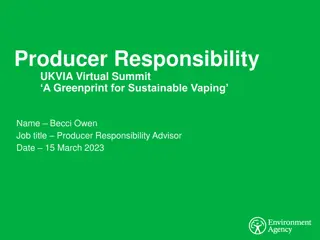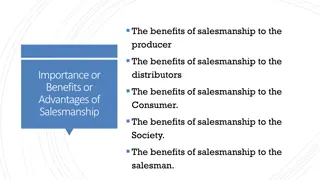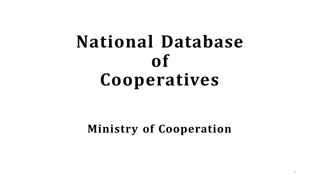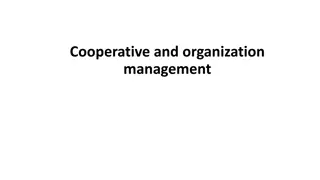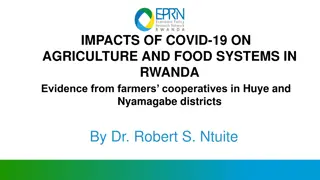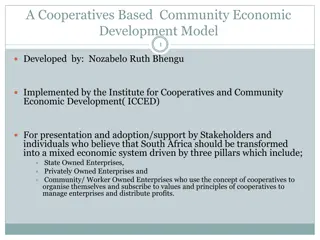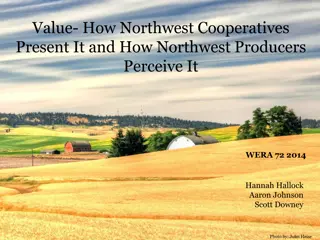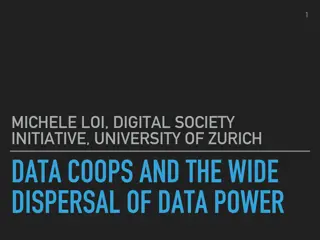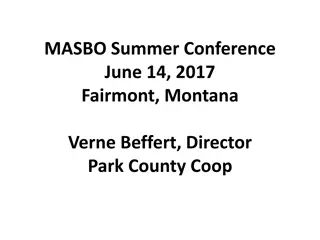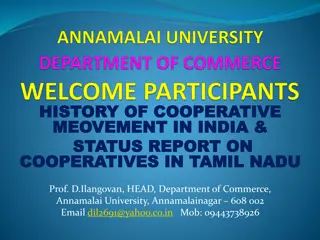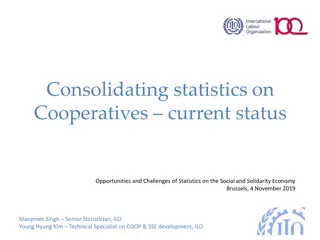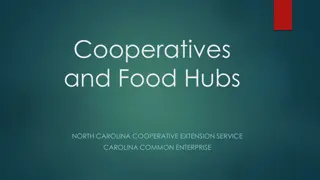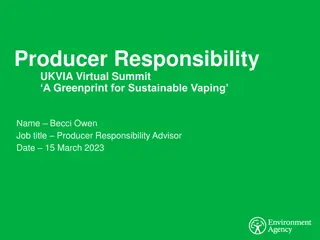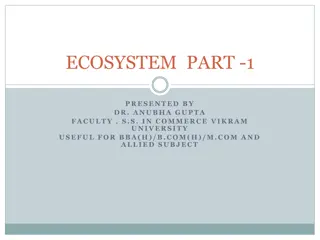Seminar on Producers Organizations and Cooperatives
This seminar focuses on the concept of Producers Organizations (POs) and cooperatives, highlighting the role of extension services in strengthening these entities. It covers the establishment steps, reviews related studies, and emphasizes the benefits of POs for rural producers. The essential features of a PO are outlined, emphasizing its role in empowering farmers and the rural poor.
Download Presentation

Please find below an Image/Link to download the presentation.
The content on the website is provided AS IS for your information and personal use only. It may not be sold, licensed, or shared on other websites without obtaining consent from the author.If you encounter any issues during the download, it is possible that the publisher has removed the file from their server.
You are allowed to download the files provided on this website for personal or commercial use, subject to the condition that they are used lawfully. All files are the property of their respective owners.
The content on the website is provided AS IS for your information and personal use only. It may not be sold, licensed, or shared on other websites without obtaining consent from the author.
E N D
Presentation Transcript
UNION IS STRENGTH WELCOME TO SEMINAR 1
2 SEMINAR ON Producers Organizations AND Cooperatives Bharath Kumar, T.P III Ph.D Student PALB 1027
3 Flow of seminar Introduction Objectives of the seminar Concept of the PO s and cooperatives Producers organization and cooperatives Role of extension in strengthening of PO s and Cooperatives. Steps in establishing PO S and cooperatives. Review of studies related to PO s and cooperatives Conclusion
4 INTRODUCTION
5 Objectives of Seminar To organizations and Cooperatives know the concept of Producers 1 To strengthening of PO s and Cooperatives. study the role of extension in 2 To know the steps in establishing PO s and cooperatives. 3 To review some of studies related toPO s and cooperatives 4
Concept of the PO 6 PO s are groups of rural producers coming together based on the principle of membership, to pursue specific common interests of their members and developing technical and economic activities that benefit their members and maintaining relations with partners operating in their economic and institutional environment. (Anonymous.2004).
FAO, 2006 7 Producers Organizations (POs) are essential institutions for the empowerment, poverty alleviation and advancement of farmers and the rural poor.
8 National Commission on Farmers , 2004 Producers organizations should be promoted to combine the advantages of decentralized production and centralized services, post-harvest management, value addition and marketing
What are the essential features of a PO? 9 It is formed by a group of producers It is a registered body and a legal entity Producers are shareholders in the organization It deals with business activities related to the primary produce It works for the benefit of the member producers A part of the profit is shared amongst the producers Rest of the surplus is added to its owned funds
Need for PO 10 Ensure better income To enhance the benefit of economies of scale To overcome the problems of intermediaries Increased bargain power of the producers More services can be made available to farmers through a single point
Contd.. 11 PO influence policies and demand for required services. Farmers can participate in the decision making process Service system becomes more effective and accountable They get better access to latest markets and technology POs can involve in Farmer and market led extension activities Build interactions between research, extension and farming systems
Different Types of Producers Organizations 12 FIGs CIGs Cooperatives Farmers associations Federations Farmers producers organization Producer Company Non-Profit Society Trust
Different legal forms of PO 13 1. Cooperative Societies Act/ Autonomous or Mutually Aided Cooperative Societies Act of the respective State 2. Multi-State Cooperative Society Act, 2002 3. Producer Company under Section 581(C) of Indian Companies Act, 1956, as amended in 2013 4. Section 25 Company of Indian Companies Act, 1956, as amended as Section 8 in 2013 5. Societies registered under Society Registration Act, 1860 6. Public Trusts registered under Indian Trusts Act, 1882
What are the taxation systems / laws governing the POs 14 Immediately after incorporation, a PO has to procure 1.PAN number from the Income Tax Department 2.TIN number from the Commercial Tax Department 3.The company has to register itself for Service Tax from Commercial Tax Department and 4.VAT from Excise department
15 Can there be a PO for non-farmers Who owns the PO Who provides support for promotion of PO Can an NGO promote PO Is registration mandatory for a PO Can a person become member of more than one PO Who will manage the PO BoM, POPI Can a PO procure produce from non-members
Benefits of Producers Organizations 16 Space for participation Improving members economic and social situation Generation and Management of financial resources
Important activities of a PO 17 a. Procurement of inputs b. Disseminating market information c. Dissemination of technology and innovations d. Facilitating finance for inputs e. Aggregation and storage of produce f. Primary processing like drying, cleaning and grading g. Brand building, Packaging, Standardization h. Quality control i. Marketing to institutional buyers j. Participation in commodity exchanges k. Export Labeling and
Basic purpose envisioned for the POs 18 For backward linkage for inputs like seeds, fertilizers, credit, insurance, knowledge and extension services; and Forward linkages such as collective marketing, processing, and market-led agriculture production
STRUCTURE OF PO 19 Producers Organization 1. Input supply 2. Financial 3. Technical 4. Insurance 5. Procurement 6. Packaging 7. Marketing 8. Networking General Body (GB) Executive Body 2 Representative per FIG Board of Directors Planning Implementation Management General Manager PO staff Local Resource person
Retailers/Processors MSP Link to Consultant Banks NSPOT/NCDEX SFI/KVK HR Plan Marketing PHI/VIUC GBY VCA NMFP RKVY HRD Support CSC Ecosystem for sustainable PO Banks Infrastruc ture Credit NBFCs 21 Inputs BDS/ERP WHR Mechanization Krishidoot FPOs as sourcing point for rural products FPOs as rural retail points for consumer products/services Services (Technical) Retailing
Producer Organizations (POs) Typical range of services provided 22 Input supply Financial & technical (Seed, fertilizer, machinery) (Credit, savings, insurance, extension) PO Marketing linkages (contract farming, procurement under MSP) Training and Networking (HRD, policy advocacy, documentation)
Optimal size and parameters of Producer Organisation (PO) 23 a. It is desirable to have a PO s for farmers having their lands in contiguous micro-watersheds b. The productive land under an PO may be around 4000 ha. c. The PO may cover generally one or two contiguous Gram Panchayats for ease of management. d. The number of farmer producers that need to be covered may be around 700 to 1000. e. The cost of managing a PO s of the above nature may be around Rs. 2 lakh per month or Rs. 24 lakh per annum.
Producer Organization Promoting Institution (POPI) 24 An NGO A bank branch A government department A cooperative society Any association or Federation
25 Roles and Responsibilities of POPI 1. Cluster identification 2. Diagnostic and Feasibility Studies 3. Business Planning 4. Mobilisation of Producers and Registration/ Incorporation of PO 5. Resource Mobilisation 6. Development of Management Systems and Procedures 7. Business Operations 8. Assessment and Audit
Limitations of a Producer organizations 26 1. A PO s should register as per the laws and act 2. Registration of a PO s is a bit difficult process 3. Requires the services of a consultant 4. The registration is a time consuming process 5. The members cannot transfer their shares freely 6. Getting a professional CEO at an affordable cost is little difficult 7. It is difficult for the illiterate members to understand statutory provisions of laws 8. Taking members in group is a biggest challenge
How much expenses will be incurred for registration of a PO 27 Particulars Item of expenditure Amount (Rs.) Application for Name of PO Fees 500 Digital signature Fees 2600 Stamp duty Memorandum of Association and Articles of Association 1500 Registration/Filing fees MoA, AoA, Form-1, Form-18, Form- 32 17200 Fees of Chartered Accountant or Company Secretary Stamps cancellation Consultancy charges 10000 300 Affidavit expenses Fees of Notary 500 Share transfer fees and Processing 5000 Miscellaneous expenses 2000 Total 39600
Financial support available for PO 28 Small Farmers Agribusiness Consortium (SFAC) 1. SFAC operates a Credit Guarantee Fund to mitigate credit risks 2. SFAC provides matching equity grant up to Rs. 10 lakh NABARD provides financial support to the POs only through project mode
30 Concept of the cooperatives Cooperatives are autonomous associations of persons united voluntarily to meet their common economic, social and cultural needs and aspirations through a jointly owned and democratically controlled enterprise
COOPERATIVES - VEHICLE FOR AGRICULTURE/RURAL DEVELOPMENT 31 Coops An Economic miracle of 19th Century - Late Honorable President of India Dr. S. Radhakrishnan Cooperatives in Rural Milieu Cooperatives - basically designed and oriented to meet economic and societal needs of rural segments, particularly the poor. Starting with agricultural credit, cooperatives encompassed all rural economic activities. Cooperatives - single largest business model in the country account for 20% of rural credit supply, 35% of fertilizer supply, 60% of sugar production, 30% of wheat procurement, 45% of cotton procurement, 40% of cloth production, 48% of milk production etc.
MEANING OF CO-OPERATION 32 Co-operative Society means A voluntary association of persons Working together with common economic objective Providing support to the members Self-help and mutual help Non-profit motive Pooling individual resources for group welfare Common benefit
Cooperatives can be registered in this acts 33 Cooperative Societies Act of Individual State Autonomous Cooperative Societies Act existing in many States (minimal State intervention) Multi State Cooperative Societies Act, which is a Central Act
Cooperatives are non-profit companies and their members liability is limited to the capital they invest. 36 Cooperatives have extended across the entire country and there are currently an estimated 230 million members nationwide. Cooperatives have advanced more credit in the Indian agricultural sector than commercial banks 80% is concerned with agriculture 60% deal with credit only Cooperatives there are two types of benefits for members Monetary benefits and Services
Share of Co-operatives in National economy 37 Rural Net work (villages covered) - 100% Milk Procurement to Total Production - 7.44% Agricultural Credit disbursed by Co- operatives - 46.15% Milk Procurement to Marketable surplus - 10.5% Fertilizer disbursed (6.049 million Tonnes) - 36.22% Ice Cream Manufacture - 45% Fertilizer production (3.293 M.T. - N&P) Nutrient - 27.65% Oil Marketed (Branded) - 50% Spindlage in Co-operatives (3.518 million) - 9.5% Sugar produced (10.400 million tonnes) - 59% Cotton Marketed / Procurement - NA Capacity Utilization of Sugar Mills - 111.5% Cotton yarn/Fabrics Production - 23.0% Wheat Procurement (4.50 million toones) - 31.8% Handlooms in Co-operatives - 55.0% Fishermen in Co-operatives (Active) - 21% Animal Feed Production/Supply - 50% Direct employment generated - 1.07 million Retail Fair Price Shops (Rural + Urban) - 22% Self-Employment generated for persons - 14.39 million Storage Facility (Village level PACS) - 65.0% Rubber processed and marketed - 95.0% Salt Manufactured (18,266 Metric Tonnes) - 7.6% Arecanut processed and marketed - 50%
Types of cooperatives 38 1. The Primary Agricultural Credit/Service Societies 2. Agricultural Non-Credit Societies 3. Agricultural co-operative Marketing Societies 4. Co-operative Farming Societies.
CAUSES OF SLOW PROGRESS 39 Government Interference Mismanagement and manipulation Lack of Awareness Restricted Coverage Functional Weakness
Characteristics of cooperatives 40 Membership Is Voluntary Members Have Strong Common Interests Members Own The Business, And Therefore Own Both The Tangible And Intangible Assets (Such As Brands And Reputation); Members Are Jointly Liable For The Enterprise s Conduct And Actions It Is Intended That The Association Will Be Permanent.
Differences between PO's and Cooperatives 41 Parameters Producer organization's Cooperatives Cooperative Societies Act Registration Indian Companies Act Area of Operation Entire Union of India Restricted Regionally Primarily agencies to provide marketing solutions to pooled produce Primarily service and delivery agencies Nature of Business Based on concept of shareholding Based on ownership of land Membership Share Transferable Not transferable Commensurate with volume of business Limited dividends on shares Profit sharing
Contd 42 Parameters Producer organization's One member, one vote. Members not having transactions with company cannot vote Cooperatives One member, one vote, but Government and Registrar of Cooperatives hold vot power Voting rights Federated into the District Central Cooperative Banks (DCCB). Business conducted is based on the policies of the DCCB. Receive financial, technical and administrative support from the government Stand-alone, self-reliant bodies with self-governing capabilities Governance Reserves Mandatory Created if there are profits More freedom and more alternatives available. POs are allowed to raise capital from external sources Borrowing Power Restricted to loans granted and disbursed by the cooperative bank to which the PAC is linked
43 Advantages of PO s and cooperatives Increased Capacity And Bargaining Power Access To New Markets Through Alternative Marketing Channels Access To Credit And Support Programmes Access To Better Technical And Market Information More Opportunities For Exchanging Experiences Greater Access To Training Programmes.
Challenges of POs and Cooperatives 44 To Achieve Clear And Efficient Internal Organization To Build Trust In The Managers Decisions To Get Members To Pledge To Deliver Products, Abiding By Previously Agreed Volumes, Conditions And Deadlines To Run Associations Profitably And Efficiently To Design And Implement Efficient And Transparent Administration Mechanisms To Establish Proper Communication And Participation Mechanisms
Role of Extension in Promotion of POs and Cooperatives 45 The role of extension vary with the role of the POs, the sectors in which the organization operates, the services organizational form used. The role of Extension in promotion of Producers Organizations (Chamala, 1990) : offered, and the (1)Empowerment Role (2)Community-Organizing Role (3)Human Resource Development Role (4)Problem-Solving and Education Role
1. Empowerment Role. 46 The role extension is to help farmers and rural communities organize themselves and take charge (empowerment) of their growth and development. The idea here is Releasing the latent energy hidden in the community and building collective actions for the common good, rather than from merely redistributing power from the haves to the have-nots.
2. Community-Organizing Role 47 Extension workers must learn the principles of community-organizing and group management skills Understanding the structure of community will help extension worker to plan, implement, and monitor their programmes Skills required for extension worker are Conflict resolution Negotiation Persuasive communication help to develop PO leaders and members
3. Human Resource Development Role 48 Development of technical capabilities of members and it must be combined with management capability The idea is Encouraging rural communities to understand their personal and group styles of managing themselves To improve their planning, implementation, and monitoring skills
4. Problem-Solving and Education Role 49 Role is prescribing technical solutions to empowering POs to solve their own problems Education role is training farmers on learning by doing approach.
STEPS IN ESTABLISHING POs AND COOPERATIVES 50 1. Understanding the village community-(need and problems) 2. Identifying potential leaders in the community 3. Talking to the identified leaders and seeking cooperation from others 4. Helping local leaders to call community meetings 5. Establishment the PO (selection of leaders in group) Source: CHAMALA, S., 1990, Establishing a group: A participative action model. Brisbane: Australian Academic Press. P. 13-38


